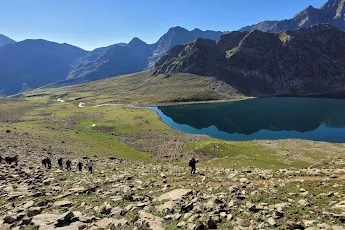Discover Best Time For Tarsar Marsar Trek & Skiing In Gulmarg

Tarsar Marsar Trek
Overview
The hikers who enjoy flower-filled valleys will find paradise on the Tarsar Marsar trek. The summer months, June to September are considered ideal for the trek. In the upper elevations, the snow starts to melt filling the valley with shades of green and the meadows blanketed with beautiful wildflowers during the monsoon season.
The days are warm ranging between 15-20°C. Unlike any other trek in the nation, it is one of the most magnificent trips in the alpine blue lakes of Kashmir. Travelers from all over India are drawn to the charm of its glacier lakes and unmatched beauty. During the monsoon time, the Tarsar Marsar trek is at its beauty.
The monsoons here are relatively dry in comparison to other states like Himachal and Uttarakhand, as it receives fewer afternoon showers giving a more pleasurable experience. It is difficult to explore during the winter months as it gets buried in the snow and is not easily accessible.
Best Time for the Trek
Summer Months (April to June)
This month is ideal for outdoor activities as the weather is more pleasant, and the days are warmer with cooler nights. The trails are usually clear as the snow has melted making the hikers easy to access with beautiful vistas of snow-capped peaks, alpine meadows, and lakes. The route follows a variety of flora and fauna, and lush foliage. You may cross various small streams formed due to the melting of the snow.
You also get a clear view of the Himalayan Ranges on your way. The temperature ranges between 10-20° in the daytime as the initial months are spring season, but nights are cooler in comparison hence it is necessary to pack appropriate thermals. Also as the spring season commences, the Tulip festival stretches for 20-25 days in April at Tulip Garden, Srinagar.
This includes heritage walks, music and dance performances, painting, and photography which is an additional point for the summer months. The beautiful Tulip flowers will make you awe-struck! Pack proper clothes and sturdy shoes as the path might become muddy due to the melting of the snow and applying sunscreen is a must to avoid the sun tans.
Monsoon Months (July to September)
The valley teems with every possible colorful flower, including pink, lavender, red, white, and so on. It’s a once-in-a-lifetime experience as the rainfall here is not very abundant, it gets light showers in the afternoon or evening and the trees gain life with the drops of rain. You might get occasional showers on the way, hence opt for waterproof jackets, shoes, raincoats, and quick-drying fabric clothes.
In late July and early August, intermittent rainfall occurs and the valley embraces spectacular beauty. As there are moderate showers in July, this leads to wildflowers popping out of wildflowers from the misted land and the fragrance of the flowers permeates the entire woods. The valley takes a different color as September enters. The Lidderwat campsite embodies the tone of early fall foliage, this is when nature indicates the arrival of Autumn.
 Skiing in Gulmarg
Skiing in Gulmarg
Overview
Known for its powdery snow and pristine landscapes, Gulmarg is a winter wonderland for sports enthusiasts. The winter months go through December to March making it ideal for skiing. And other sports activities like snowboarding, heli-skiing, snowmobile, etc. It gets covered with a thick layer of snow drawing skiers of all levels from beginners to experts from all over the world.
In the peak season known for the Gondola, which runs round around the clock to accommodate sports lovers to different slopes. But the best months are said to be January and February as they have consistent snow powder with deep snowpacks and views of the Himalayan peaks due to clear blue skies around. In comparison to the busiest months, March offers milder temperatures and fewer crowds.
Best Time for the Skiing
Winter Months (October to March)
With leaves falling, approaching Autumn makes the environment more calm and peaceful. The winter months fall between December and March, making it the best time for skiing in Gulmarg and attracting people from all over the world. Tourists witness snowfall and chilly weather.
To fulfill your wish on the bucket list, this is the ideal time. Sometimes winter approaches late and may not snow in December, therefore it is necessary to keep updated with the meteorological data. January and February receive ample amounts of snowfall which has a powdery consistency and is packed to a height of 50-60cm making skiers of all levels glide and turn. The best time is said to be the third week of January through late February which has excellent snow.
It is said to receive double the snowfall than that of the European Alps. You can reach different slopes from Apharwat to Kongdoori slopes by opting for a Gondola ride which can be booked online through the J & K tourism department. Ski equipment can be rented and trained by the instructor. Proper techniques and expertise will enhance safety on slopes and never compromise on quality gear equipment and instructor.
The breathtaking sights of snow-peaked mountains and icicles on coniferous pine trees make it more scenic. As March approaches, there is less crowding and precipitation occurs transitioning from winter to early spring. Sometimes if the weather stays good then skiing season may extend up to AprilSkiing at high altitude leads to exhaustion and dehydration, so stay hydrated by drinking plenty of water and carrying snacks containing nutrition to stay energetic throughout the day.
Add Your Comment
Use the following form to leave your comment on this article.
